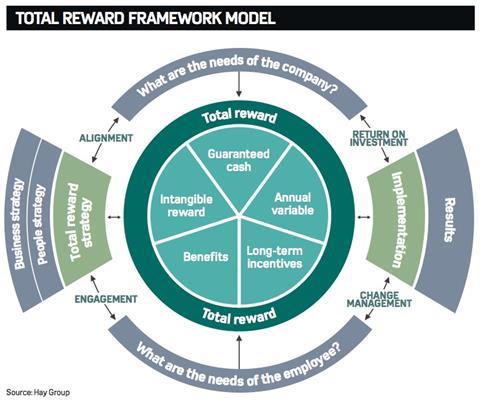
If you read nothing else, read this…
- An EVP comprises the benefits and rewards that employers offer employees in addition to, and often as part of, their employment contract.
- An employer’s brand is key in attracting, retaining and motivating talent .
- Benefits should be engaging and relevant for staff.
A number of recent surveys suggest that the war for talent is about to start. For example, the2014 Employment Trends Survey , published by recruitment consultancy Michael Page in January 2014, found that almost half (48%) of small- and medium-sized enterprises (SMEs) will increase their headcount this year.
This suggests that the war for talent will extend from large employers all the way down to their smaller peers, increasing the urgency with which employers must consider the shape and effectiveness of their EVP.
An EVP comprises the benefits and rewards that employers offer employees in addition to, and often as part of, their employment contract. A comprehensive EVP will help to attract, retain and motivate staff.
Enticing benefits
An enticing EVP that attracts top talent considers employees’ needs and motivates them to put in discretionary effort by offering them a range of financial, experiential, personal and employee-specific rewards.
Wolf-Bertram von Bismarck, talent practice leader for Europe, the Middle East and Asia (EMEA) at Aon Hewitt, says these benefits can range from health and wellness rewards to retirement savings support and paid time off, as well as perks that enhance an employee’s workplace experience.
“So, the work environment, the leadership culture, the work/life balance and development opportunities and career development could be considered,” he says. “There are a lot of things that can be rewarding.”
External perception

To date, employers have typically created their total reward proposition without regard for the needs of their workforce or business, let alone prospective recruits, but this is now changing, with enlightened employers creating more tailored reward offerings.
Stuart Hyland, business leader, UK reward solutions consulting, at Hay Group, says: “I think there is a natural extension to that, which looks at external perceptions as well. I think employer brand is taking total reward one step further and [involves employers] thinking about the external implications of decisions that are made, and the shape of the package.”
Corporate brand
This growing focus on the market perception of organisations is resulting in a growing number of employers using their corporate brand and values to underpin their EVP strategy in a bid to attract top talent.
Some employers, such as law firm Withers , are creating EVPs bursting with corporate social responsibility (CSR)-based benefits to appeal to the more ethically- and morally-minded younger generations coming into the workplace. This approach also helps employers to engage and retain talent after they join the organisation.
Francis Goss, sales and marketing director, employee solutions, at Grass Roots, says: “Where an employer really wants to get across their green credentials, they may offer a range of benefits to help illustrate that, and some of the brands they align with will also help to illustrate that.”
Environmentally-friendly benefits, such as bikes for work, are a case in point.
Grass Roots offers its own staff a financial incentive to car share, use public transport or walk to work.
Similarly, a family-friendly employer may offer its staff access to flexible working, childcare vouchers, and retail and discount cards, either on an employer-funded basis or through a voluntary benefits scheme .
Employees are far more likely to trust, and go the extra workplace mile for, employers that offer an EVP that supports their corporate branding and values, which underlines the importance of an EVP.
Future reward
Hay Group’s Hyland says corporate branding will help shape the future of total reward. “I do think there is a strong argument that employer brand is the total reward of the future,” he says.
“I get worried for employers that still have very narrow perceptions of total reward, and are struggling with that concept. With the economy starting to recover, they could get left behind if they have some more forward-thinking competitors.”
But for now, employers should focus on how they present their EVP.
Grass Roots’ Goss says: “When putting together a strong proposition, as in ‘why should [talent] work for this employer?’, what we find is that the richness of the employee proposition around the benefits piece is absolutely used to attract talent, and the way in which it is presented is important as well.”
Goss adds that an EVP is not just about an employer having, say, a flexible benefits platform , but about it presenting the platform in a way that is relevant to individual employees.
A comprehensive and well-presented EVP will be talked about by employees, thereby creating an army of corporate brand ambassadors worth their weight in recruitment gold. So employers that want to win the impending war for talent should get cracking with their strategy right away.
Case study: Capital One builds enticing employee value proposition

Capital One has built an employee value proposition (EVP) that aims to support the organisation as a great place to work and engage and retain employees.
The EVP focuses on benefits in the context of total reward. It covers the standard benefits offered by the organisation, such as private medical insurance , pensions and bikes for work , and also ensures that staff are given details about their working environment, development opportunities and health and wellbeing initiatives .
Jill Cunnison, head of benefits and HR operations at Capital One, says: “We try to look at benefits in their broadest sense. Core benefits do feature within that, but we try to talk about benefits in the round and connect all of those offers together. That’s at the heart of the employee value proposition.
“We try to connect all of those things together for our employees in different ways. It’s very unusual for us to talk about one pure benefit.”
The credit card organisation has a strategy to add value, wherever it can, to support employees, which could involve negotiating benefits schemes with outside providers. For example, when it was looking at its health and wellbeing strategy and how it could maximise its offer in a cost-efficient way, Capital One brought a personal trainer into its on-site gym to offer employees classes and personal training sessions.
“That’s a really nice part of the benefits, but it’s more about us making the connections than spending money,” says Cunnison. “It’s much richer than those standard elements.
“When you make those connections, you then look at the broader footprint of benefits as a whole, and it helps people feel good about working for us and also in terms of attracting people into our organisation.”
Capital One ensures its employees are aware of all aspects of its EVP through regular communications, including an HR fair held each December to coincide with its flexible benefits enrolment window. All relevant parties take part in the fair, including third-party providers and the recruitment, development and communication teams.
“It really is around the [employee] proposition and that goes down really well,” says Cunnison. “We talk about standard benefits, but we connect everything together.”
Viewpoint: Gary Moss: Internal and external brands must align

We work with many blue-chip organisations, and the alignment of internal and external values is always an issue for them. A number of employers invariably ask why value alignment matters and if yes, why?
Our response is simple: of course it matters. This is because the ’insides’ of organisations inevitably leak out. By this, we mean that an organisation’s internal values always manifest themselves externally, which is why employers must practice what they preach internally, as well as within the market they operate.
Employers might get away with misalignment for a while, but if they don’t align their values, they will spring leaks, with the inevitable consequence of damage to their brand and employee reputation.
No-brainer
Aligning internal values with external values is a no-brainer. Employers that get it right will see their business thrive.
Recent research by Harvard and Gallup found that aligned organisations deliver twice the market share, 38% less absenteeism and 18% more productivity.
The key to getting it right is based on one simple belief: that everyone is a brand builder, from marketing and operations to HR and finance. There are no exceptions.
We can no longer say one thing to our customers while rewarding and recognising different things internally. This has an impact on the business, as consumers desert the brand and employees increasingly want to work for those that align with their own values.
Employee satisfaction
Alton Towers, part of Merlin Entertainments, which successfully floated last year, was bottom of both its customer and employee satisfaction leagues six years ago. They it aligned its values, and now it is at the top of both leagues.
Internal and external values therefore have to be aligned, because success in one leads to success in the other.
Gary Moss is chairman of Brand Vista


















